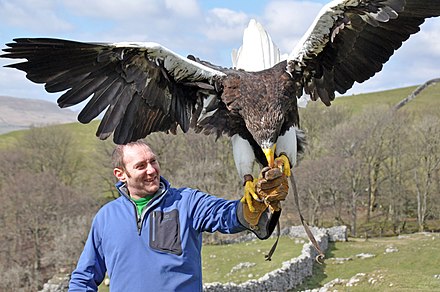Steller’s Sea Eagles (Haliaeetus pelagicus) are large, powerful birds of prey known for their striking appearance and fish-dominated diet. While there is no direct evidence or scientific research indicating whether Steller’s Sea Eagles have a sense of smell, it is likely that they do, as most birds have at least some ability to detect odors.
Do Steller’s Sea Eagles Have a Sense of Smell?
The sense of smell in birds is generally not as well-developed as it is in mammals, and its role in their behavior and survival is not as extensively studied. However, some studies have suggested that birds can use olfactory cues to locate food sources, such as schools of fish or carcasses.
In the case of Steller’s Sea Eagles, their sense of smell, if present, might play a role in their foraging and hunting strategies, as they primarily feed on fish and other aquatic organisms. Visual cues are likely to be more important for Steller’s Sea Eagles, given their reliance on sight for hunting and their preference for open aquatic habitats.
Factors Affecting the Sense of Smell in Steller’s Sea Eagles
 Image source: stellers sea eagle
Image source: stellers sea eagle
Several factors can influence the development and use of the sense of smell in Steller’s Sea Eagles:
-
Habitat and Feeding Habits: Steller’s Sea Eagles primarily inhabit coastal and marine environments, where visual cues may be more reliable for locating prey than olfactory cues. Their reliance on fish and other aquatic organisms as their primary food source may also reduce the need for a highly developed sense of smell.
-
Evolutionary Adaptations: As birds of prey, Steller’s Sea Eagles have evolved to rely more heavily on their visual and auditory senses for hunting and navigation. The development of their sense of smell may have been less of a priority during their evolutionary history.
-
Environmental Conditions: The marine and coastal environments where Steller’s Sea Eagles live may not provide as many olfactory cues as terrestrial habitats, which could limit the need for a well-developed sense of smell.
Comparison to Other Birds of Prey
While the sense of smell in Steller’s Sea Eagles is not well-understood, it is worth comparing their olfactory abilities to those of other birds of prey:
- Vultures: Vultures, such as the Turkey Vulture, are known to have a relatively well-developed sense of smell, which they use to locate carrion from a distance.
- Hawks and Falcons: These birds of prey are generally considered to have a less developed sense of smell compared to vultures, with a greater reliance on visual and auditory cues for hunting.
It is possible that Steller’s Sea Eagles, as a large bird of prey, may have a sense of smell that is more similar to hawks and falcons than to vultures, but more research is needed to confirm this.
Potential Role of Smell in Steller’s Sea Eagles
While the exact role of the sense of smell in Steller’s Sea Eagles is not well-understood, there are a few potential ways it could be used:
-
Locating Prey: As mentioned earlier, some studies have suggested that birds can use olfactory cues to locate food sources, such as schools of fish or carcasses. This could be a potential use of the sense of smell for Steller’s Sea Eagles.
-
Nest Site Selection: Birds may use olfactory cues to assess the suitability of potential nest sites, such as the presence of predators or the availability of resources.
-
Social Interactions: Olfactory communication can play a role in social interactions, such as territorial marking or individual recognition, in some bird species.
However, these potential uses of the sense of smell in Steller’s Sea Eagles are speculative and would require further research to confirm.
Conclusion
In conclusion, while Steller’s Sea Eagles may have some ability to detect odors, the role of their sense of smell in their behavior and ecology is not well understood and likely plays a minor role compared to their visual and tactile senses. More research is needed to fully understand the olfactory capabilities of these impressive birds of prey.
References:
- Steller’s Sea-eagle | San Diego Zoo Animals & Plants. (n.d.). Retrieved from https://animals.sandiegozoo.org/animals/stellers-sea-eagle
- Steller’s Sea Eagles (Haliaeetus pelagicus) Information – Earth Life. (n.d.). Retrieved from https://earthlife.net/stellers-sea-eagles/
- Haliaeetus pelagicus – Steller’s sea-eagle – Animal Diversity Web. (n.d.). Retrieved from https://animaldiversity.org/accounts/Haliaeetus_pelagicus/
- What a Roving Steller’s Sea Eagle May Tell Us About Ourselves. (2023, May 22). Retrieved from https://www.atlasobscura.com/articles/stellers-sea-eagle-in-maine
- The Economics of the Steller’s Sea-Eagle – Maine Birds. (2023, November 14). Retrieved from https://web.colby.edu/mainebirds/2023/11/14/the-economics-of-the-stellers-sea-eagle/

